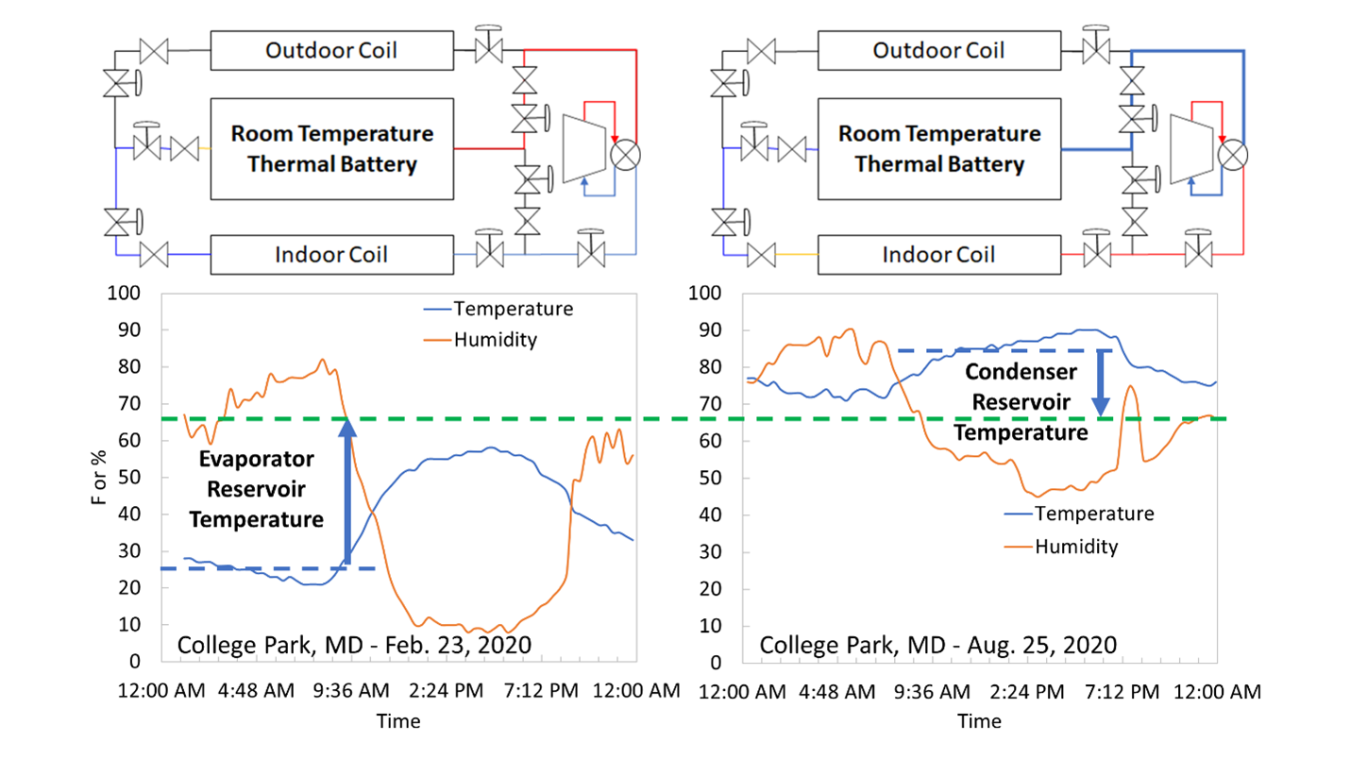Lead Performer: University of Maryland – College Park, MD
February 15, 2022
Schematic of the dual-purpose thermal battery integrated heat pump operating in both heating and cooling seasons.
Lead Performer: University of Maryland – College Park, MD
Partners:
-- Oak Ridge National Laboratory – Oak Ridge, TN
-- Electric Power Research Institute – Palo Alto, CA
-- Insolcorp – Albemarle, NC
-- Heat Transfer Technologies – Prospect Heights, IL
-- Rheem – Atlanta, GA
Total Funding: $3,750,000
DOE Funding: $3,000,000
Cost Share: $750,000
Project Term: October 1, 2021 – September 30, 2024
Funding Type: BENEFIT 2020 Funding Opportunity Announcement
Project Objective
The technology proposed by this project consists of a dual-purpose heating and cooling thermal battery with room temperature storage integrated with a heat pump for commercial building applications. The thermal battery serves as the heat reservoir that absorbs heat when operating as a condenser in cooling mode or rejects heat when operating as an evaporator in heating mode. The objective of the project is to develop and validate an integrated 5-ton heat pump-thermal storage system that can operate in both cooling and heating modes and achieve ≥50% demand reduction for four hours and ≥20% total energy efficiency improvement for all modes at a storage system cost of ≤$15/kWhthermal.
The value proposition of this project includes:
- Flexibility – using a single PCM at room temperature, the system may be used for both cooling and heating modes
- Efficiency – the room temperature PCM allows for reducing the cycle’s temperature lift, considerably increasing the efficiency of the heat pump
- Load shifting – the thermal storage enables load shifting by leveraging the higher coefficient of performance during on-peak hours, which will consequently result in cost savings
The project is divided in three phases, approximately one year each in duration, comprising the following:
- Component and system design, prototyping, and component testing
- Full-scale system construction and laboratory testing
- Field testing and validation
Project Impact
Commercial buildings in the U.S. accounts for more than 40% of the total electricity consumption. Thermal energy storage is a key for more efficient energy management, particularly for HVAC&R equipment, which is responsible for a majority of the electricity consumed in commercial buildings. However, key barriers preventing the adoption of thermal storage in building equipment are high upfront cost and space usage.
This project will provide a single solution to address both cooling and heating with a single compact system that can efficiently shave peak-loads, provide cost-savings during every season, and have the potential for significantly lower upfront costs. The project will include design and proper material selection to further reduce the cost of the thermal battery and create a path forward to meeting DOE’s targets for thermal energy storage performance and cost per kWh. The successful completion of this project will lead to a cost-effective technology with the potential to significantly offload the electrical grid.
Contacts
DOE Technology Manager: Sven Mumme
Lead Performer: Reinhard Radermacher, University of Maryland

